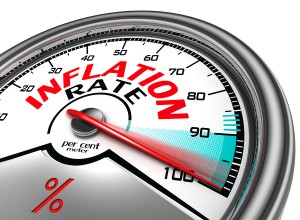Canadians will experience a higher cost of living this year as the inflation rate increased to a two-year high of two percent, according to a report released last Friday by Statistics Canada. The federal agency reported the Consumer Price Index (CPI) increased 1.5 percent from the previous month.
Annual energy prices were the biggest factor to the substantial rise. Energy costs in the Great White North increased 8.4 percent in the past 12 months: gasoline prices soared 6.6 percent in the past year, natural gas prices skyrocketed 26 percent and electricity prices rose 4.6 percent.
 The core rate, meanwhile, which excludes eight volatile products like energy, mortgage interest cost, transportation and vegetables, increased only 1.4 percent after a previous boost of 1.3 percent. Bank of Montreal economist Doug Porter stated that food, auto and clothing prices “are running close to average.”
The core rate, meanwhile, which excludes eight volatile products like energy, mortgage interest cost, transportation and vegetables, increased only 1.4 percent after a previous boost of 1.3 percent. Bank of Montreal economist Doug Porter stated that food, auto and clothing prices “are running close to average.”
Bloomberg News survey forecasts had been correct in projecting the increases.
Consumer prices rose in six provinces last month: Newfoundland and Labrador, Nova Scotia, New Brunswick, Quebec, Ontario and British Columbia. Consumer prices remained the same or decreased in Prince Edward Island, Manitoba, Saskatchewan and Alberta.
When compared to other countries, Canada’s inflation rate is similar to the United States, a little bit higher than Great Britain and slightly greater than the eurozone. It was definitely less than Australia’s 2.8 percent.
Bank of Canada Governor Stephen Poloz said that the inflation rate hit the central bank’s target for the first time in two years, though he noted in a statement that he would dismiss higher energy costs because of the economic slowdown.
In addition, Poloz, who succeeded Mark Carney last year, noted that he will intend to focus more on “spare economic capacity” in order to maintain the core inflation rate below two percent until the first quarter of 2016. The central bank will announce its policy interest rate Jun. 4, which has stayed at one percent for four years now, the longest time since the post-World War II era.
“Ideally, the return of core and headline inflation to the 2 per cent target should be the fruit of a more robust economy closer to full potential,” Sebastien Lavoie, assistant chief economist at Laurentian Bank Securities in Montreal, wrote in a research note prior to the publication of Friday’s report. “However, Canada’s economy seems far from that reality. Policy rate hikes are, consequently, far from reality as well.”
In the U.S., it is expected that the interest rate will remain at near zero until later next year. In a recent policy meeting, the Federal Reserve indicated that it is transitioning from focusing on tapering its quantitative easing program to attempting to raise interest rates as both the economy and inflation rates accelerate.
“Because the Federal Reserve has not previously tightened the stance of policy while holding a large balance sheet, most participants judged that the committee should consider a range of options and be prepared to adjust the mix of its policy tools as warranted,” the minutes of the Federal Open Market Committee (FOMC) Apr. 29 and 30 meeting.
Consumer prices in the U.S. were up 1.1 percent in the month of March, while prices omitting the volatile categories jumped 1.2 percent.



